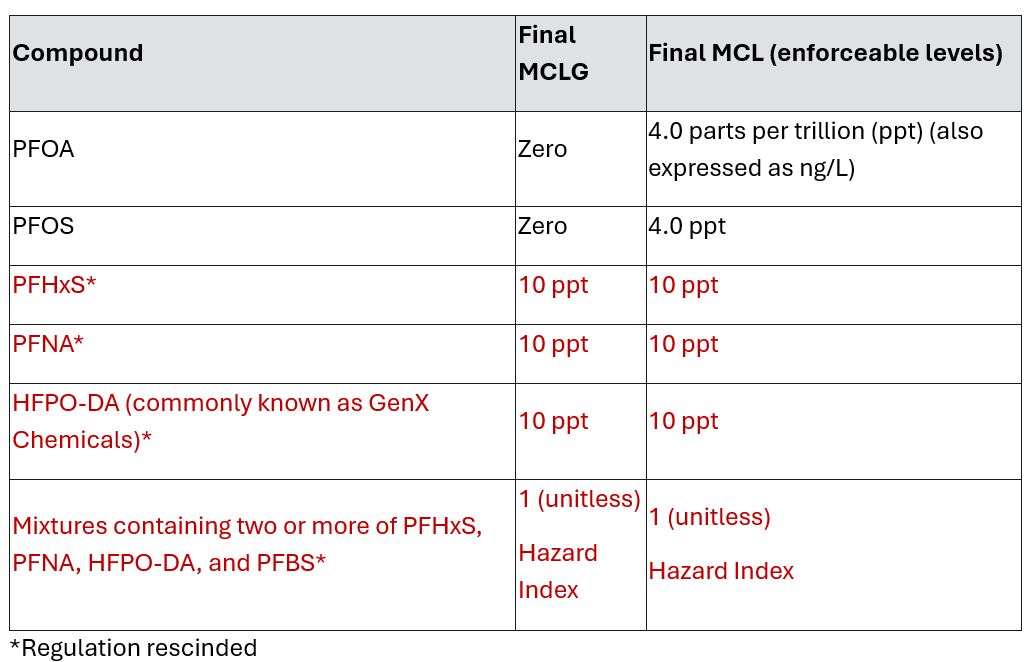
PFAS Regulatory Overview
FINAL PFAS NATIONAL PRIMARY DRINKING WATER REGULATION
On May 14, 2025, EPA announced the following intended changes to the PFAS National Primary Drinking Water Regulations (NPDWRs):
Perfluorooctanoic acid (PFOA) and Perfluorooctane sulfonic acid (PFOS): The agency will keep the current NPDWRs for PFOA and PFOS.
They announced the intent to extend the Maximum Contaminant Level (MCL) compliance deadlines for PFOA and PFOS (from the original 2029 date, a common proposal is to extend it to 2031).
They also intend to establish a federal exemption framework to provide flexibility for water systems facing compliance challenges.
The EPA also announced its intent to rescind the regulations and reconsider the regulatory determinations for PFHxS, PFNA, HFPO-DA (commonly known as GenX), and the Hazard Index mixture of these three PFAS plus PFBS.
The stated purpose for rescinding and reconsidering these specific chemicals is "to ensure the determinations and any resulting drinking water regulation follow the Safe Drinking Water Act process."
COMPREHENSIVE ENVIRONMENTAL RESPONSE, COMPENSATION, AND LIABILITY ACT (CERCLA)
In April 2024, the EPA finalized a rule designating Perfluorooctanoic acid (PFOA) and Perfluorooctane sulfonic acid (PFOS) (including their salts and structural isomers) as hazardous substances under CERCLA Section 102(a).
This designation subjects PFOA and PFOS to the full authority of the Superfund law, which enables:
Strict Liability: Imposing retroactive, strict, and joint and several liability for cleanup costs on Potentially Responsible Parties (PRPs) (e.g., current and former facility owners/operators, disposers, and transporters).
Cleanup and Enforcement: Allowing the EPA to order, conduct, and recover costs for the investigation and remediation of PFOA and PFOS contamination.
Reopening Sites: Existing Superfund sites may be reopened to address PFOA and PFOS contamination.
Release Reporting Requirements:
Any entity in control of a facility must immediately report a release of PFOA or PFOS that meets or exceeds the Reportable Quantity (RQ) to the National Response Center (NRC), and state/local emergency response authorities.
The RQ for PFOA and PFOS is set at one pound (1 lb.) within a 24-hour period.
CLEAN WATER ACT (CWA)
The CWA gives the U.S. EPA the authority to regulate non-potable water. The development of standardized testing methods is a cornerstone of CWA regulation.
EPA Method 1633:
Status: Finalized in collaboration with the Department of Defense (DoD). While finalized, it still needs to be formally proposed and promulgated through rulemaking to be nationally required for CWA compliance, though the EPA strongly recommends its use now.
Scope: It is the foundational method for analyzing PFAS in non-potable water and other environmental media.
Matrices: Wastewater (influent and effluent), surface water, groundwater, landfill leachate, soil, sediment, biosolids (sewage sludge), and fish/shellfish tissue.
Target Analytes: Measures 40 specific PFAS compounds using Liquid Chromatography-Tandem Mass Spectrometry (LC-MS/MS).
Other Relevant Testing Methods:
EFFLUENT GUIDELINES PROGRAM
Effluent Limitation Guidelines (ELGs) establish national technology-based regulatory limits for specified pollutants in wastewater discharge by requiring industries to adopt the Best Available Technology (BAT) to reduce or eliminate discharges. The U.S. EPA updates its Effluent Guidelines Program Plan every two years. Regulation for PFAS under the ELGs is still in development. Until federal ELGs are finalized, states are increasingly using their authority under the NPDES permitting program to impose case-by-case, technology-based, and water quality-based effluent limits for PFAS on discharging facilities.
EPA has identified and is studying several key industries that are significant sources of PFAS discharge, with specific rulemaking actions planned:
Landfills: In the Final ELG Plan 15 (Jan 2023), the EPA determined that revised ELGs and pretreatment standards are warranted for reducing PFAS in landfill leachate discharges.
PFAS Manufacturers (Organic Chemicals, Plastics, & Synthetic Fibers - OCPSF): This sector, which includes PFAS production, was a major focus. A proposed rule was under development but was withdrawn for review by a new administration in January 2025. The EPA has since indicated a commitment to move forward with ELGs for this sector in some form.
Metal Finishing and Electroplating: This category was also targeted for future rulemaking due to PFAS use in certain processes.
EPA continues to collect data and conduct detailed studies on other categories to inform future ELG decisions, including:
Textile Mills
Pulp, Paper, and Paperboard
Airports
Centralized Waste Treatment (CWT) facilities
Battery Manufacturing
FIFTH UNREGULATED CONTAMINANT MONITORING RULE (UCMR 5)
UCMR 5 is designed to collect data on contaminants suspected to be present in the nation’s public water systems but that do not yet have health-based standards set under the Safe Drinking Water Act (SDWA). The EPA is authorized to issue a new list of 30 contaminants every five years. Of the 30 contaminants in UCMR 5, PFAS account for 29. (The 30th is the metal lithium) Under UCMR 5, all public water systems (PWS) serving more than 3300 people plus a randomly selected set of 800 smaller systems will be required to test for these compounds at entry points to their drinking water distribution systems in 2023.


